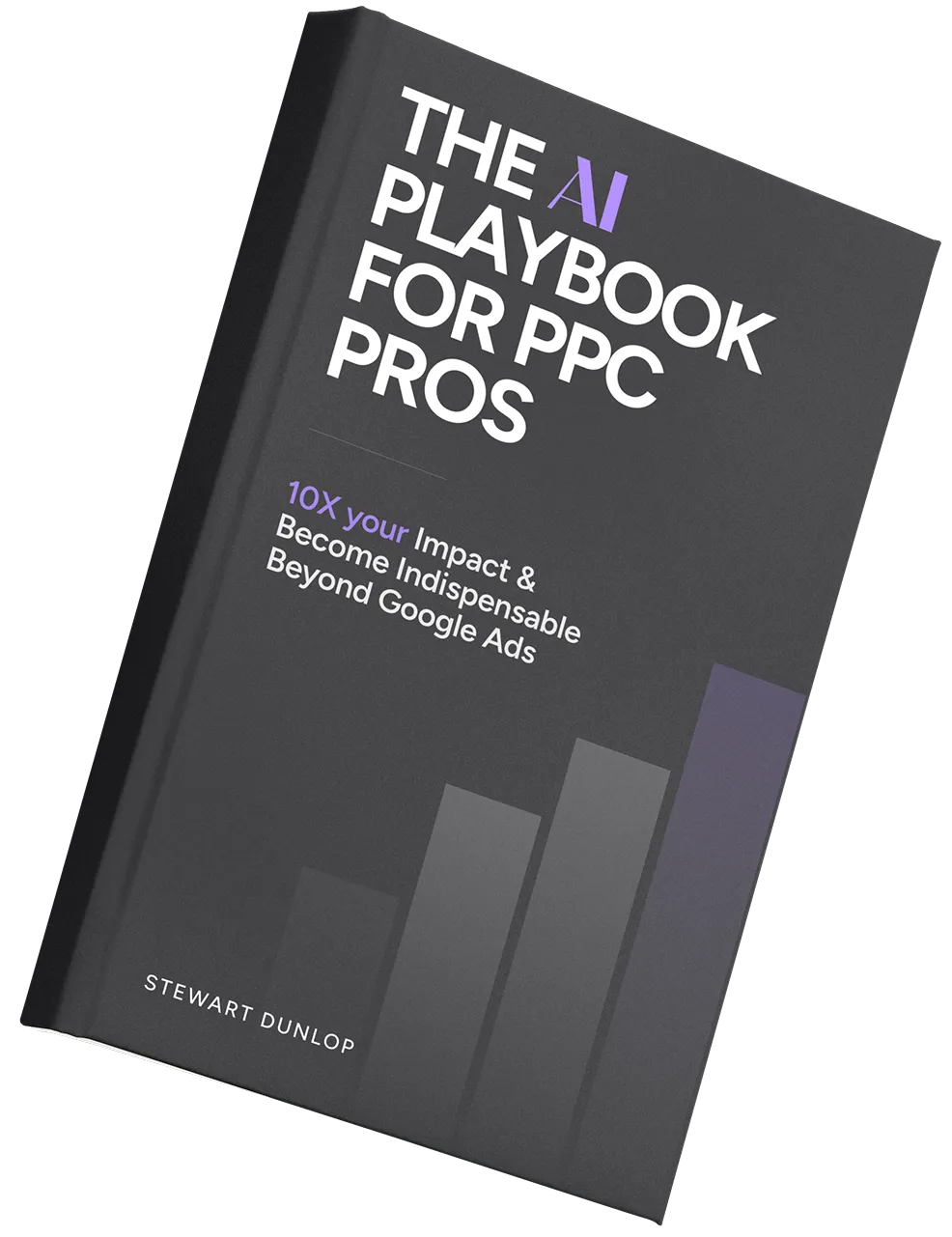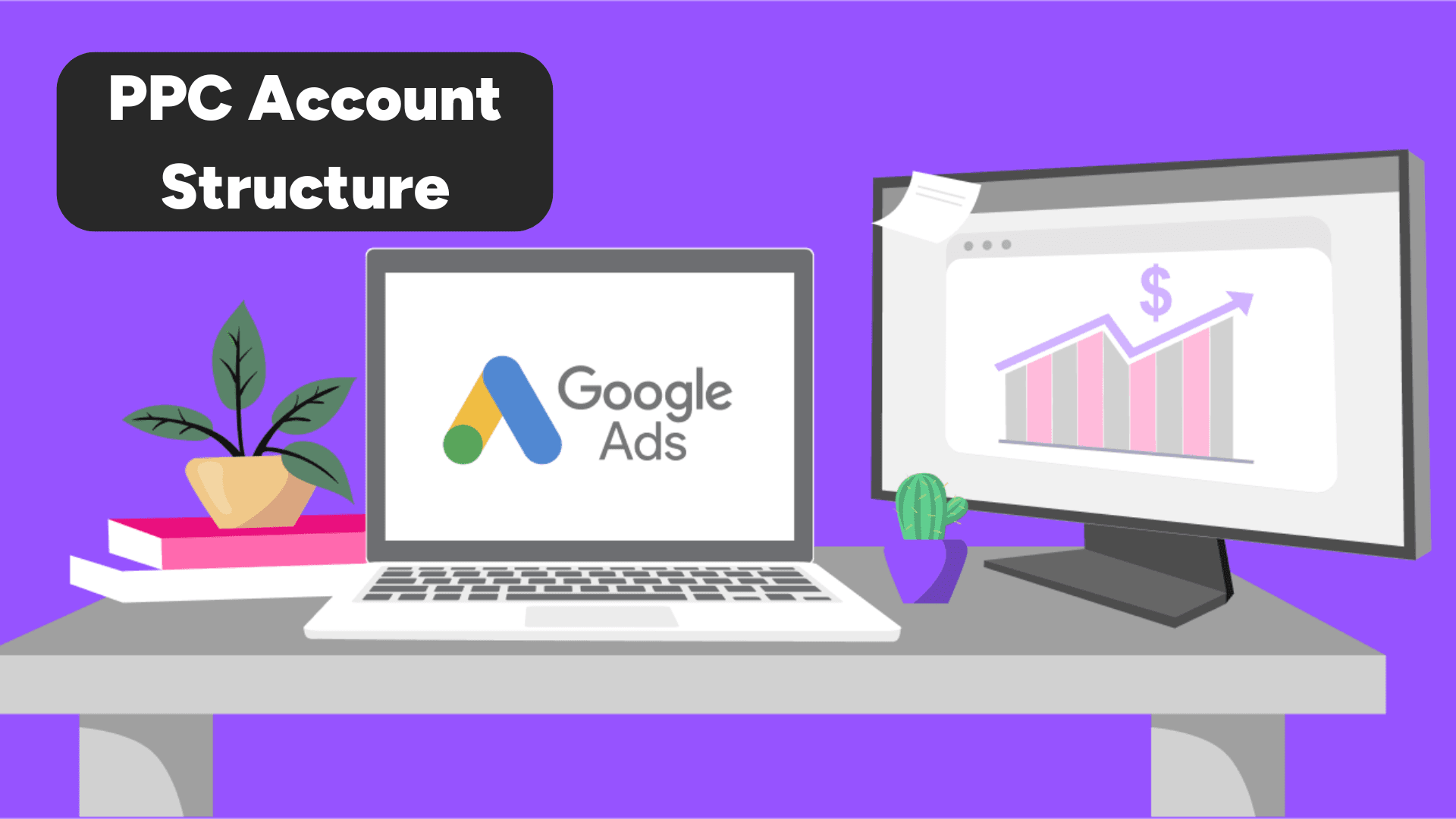
Account structure for Google Ads refers simply to how you structure all the ads in your account.
It’s actually very straightforward, and we can create some basic different structures depending on our type of business.
This guide will show you how to structure your Google ads account in 10 minutes, with some real life examples that we've personally used at PPC.io, our PPC agency.
Google Account Automation 🤖
Google doesn’t want our ads account to be heavily segmented, in order to allow their machine learning powers to do its thing.
However, as marketers, we want to maintain some control over our Google ads and make sure keywords are matched up well to different landing pages, and so that we can eliminate poor performing ads and keywords.
Google Ads Wants:
- Large volumes of learning data at the ad group level.
- Because this improves smart features such as bidding and responsive search ads.
- And removes the human element (requirement).
We want:
- Control of budget delivery across the best performing areas of our Google ads account.
- Strategic decision making that doesn’t let Google Ads make all the decisions for you.
- Better control of negative keywords.
- Better control of landing pages that match user intent.
Google Ads Account Structure Breakdown
Time to show you exactly how you should structure your Google ads account for optimal performance.
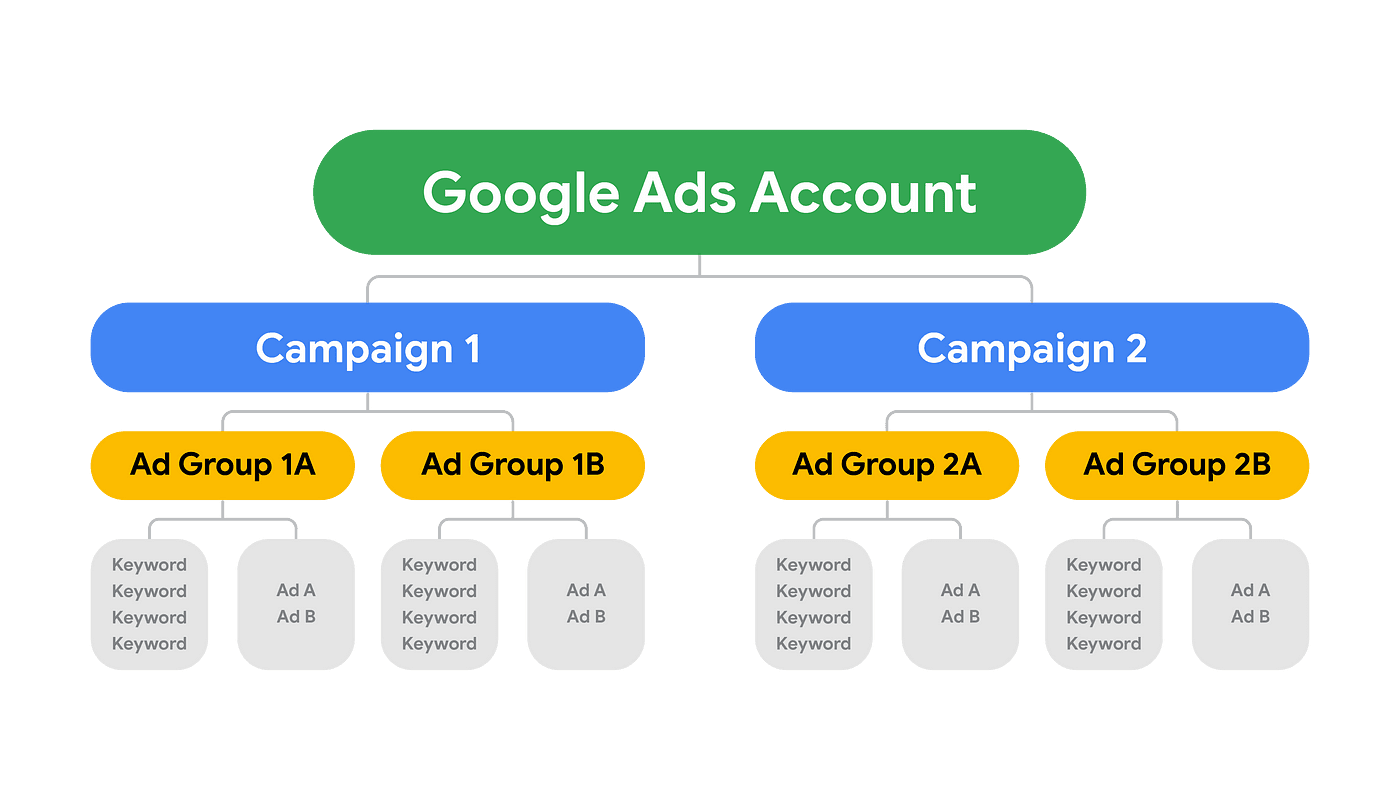
Account Level
This is the very top level of your Google ads account structure.
It's simply your Google ads dashboard.
From here you can set things like your assets (logos, phone numbers etc.) and look at various insights across the whole account.
Campaign Level
The next level down within your Google ads account structure is the 'campaign level'.
Generally speaking nowadays, your campaign type will typically fall under one of the following:
- Search campaign
- Shopping campaign
- Performance Max campaign - Covers absolutely everything (YouTube, display, gmail, search, shopping etc.) powered by Google AI 🤖
(See the differences between shopping & performance max in this article)
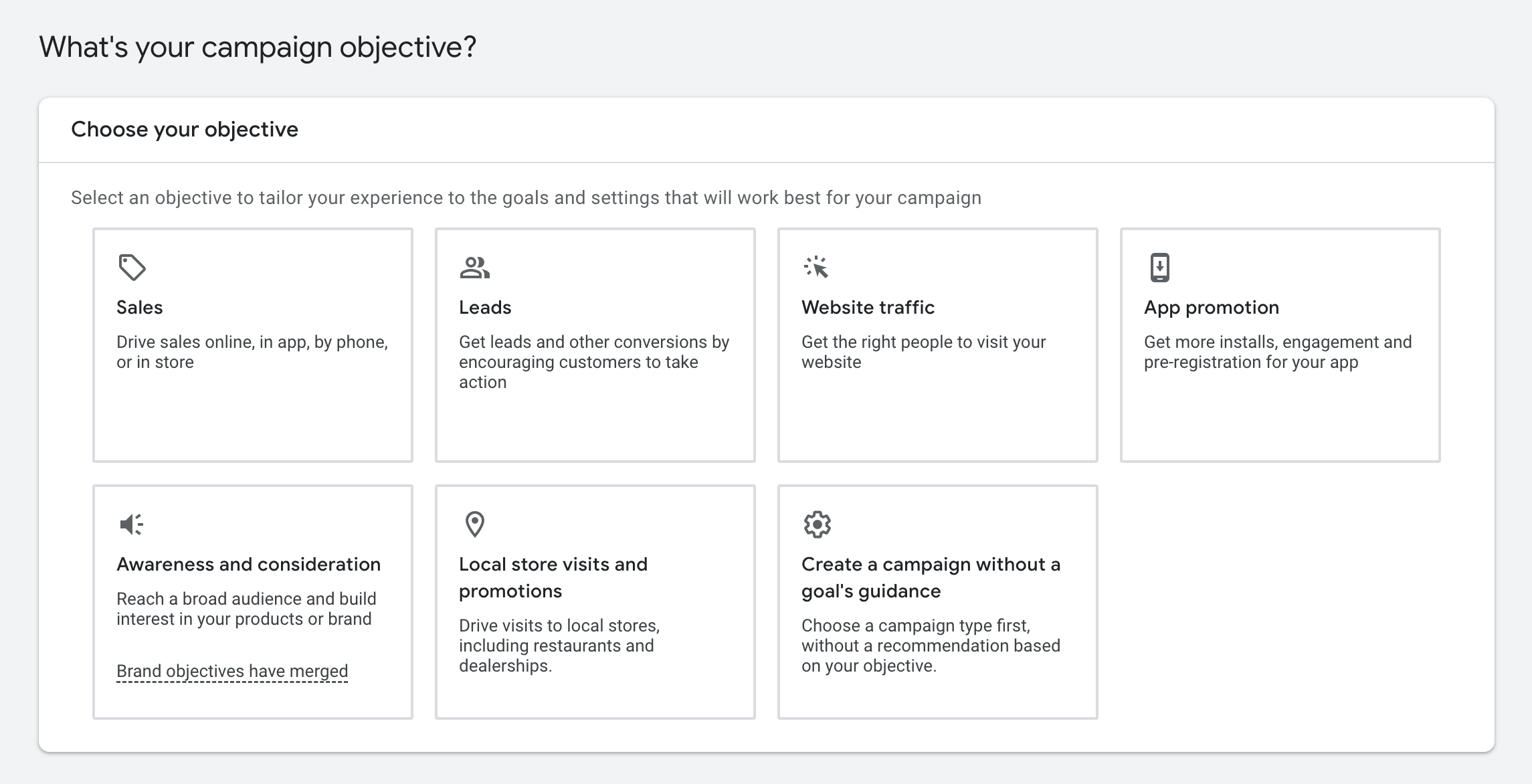
And then you'll select your campaign type...
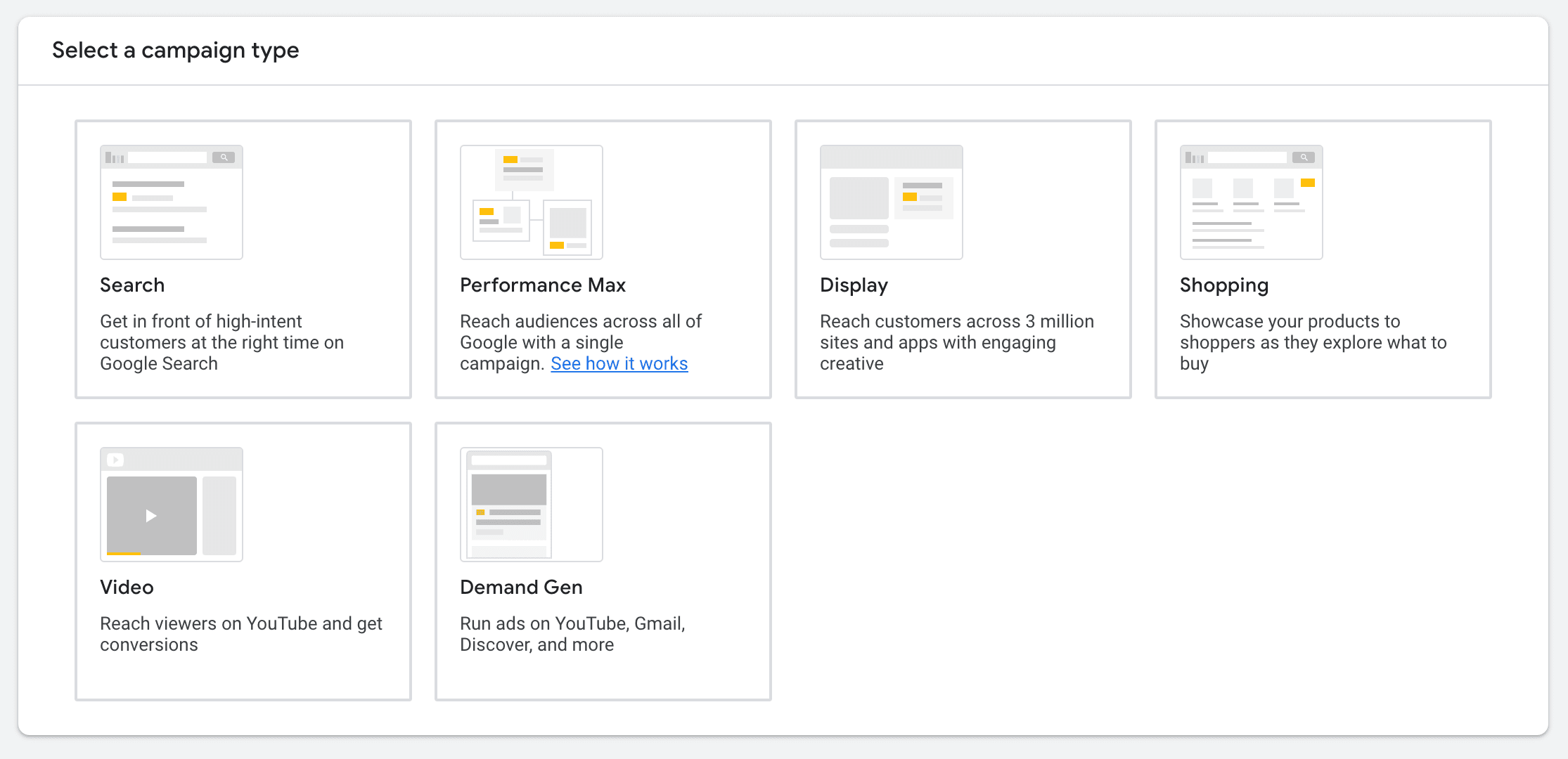
Example Campaigns - Insurance
Here's a few hypothetical campaigns you might create within your Google ads account if you're an insurance company.
- Campaign 1 - “Search - Car Insurance”
- Campaign 2 - “Search - Life Insurance”
- Campaign 3 - “Search - Brand”
- Campaign 4 - “Performance Max - Car Insurance”
Ad Group Level
The next level down within our Google ads account structure is "ad groups." This is where we start to get more granular!
Ad groups are used to organize Google ads by theme or product type, leading to more targeted ad delivery.
Car Insurance Example
Example - Car Insurance
Within a car insurance campaign, we may have the following different ad groups:
- Ad Group 1 - Cheap car insurance
- Ad Group 2 - Luxury car insurance
- Ad Group 3 - New driver car insurance
Typically you'll have quite a few different ad groups within your Google ads account, targeting various different products or services aimed at different customer types.
Keywords Level
The next level of our Google ads account is the keyword themselves.
We need to select all of the keywords that we want to target within each ad group. These are literally the keywords that we want our ads to display for whenever someone searches on Google.
We can select the following keyword matches:
- Broad match - Google ad's machine learning will pick out any keywords it thinks are a good match, even if they're very broad.
- Phrase match - Google ad's machine learning will pick out phrase matches that are considerably closer.
- Exact match - Only very close variants of your keyword will be matched.
Let's take a look at an example below.
Example - New Driver Car Insurance
Some keywords selected below:
- Car insurance for new drivers - exact match
- Car insurance just passed driving test - exact match
- Car insurance first time driver - phrase match
- Car insurance for 17 year olds - phrase match
- Car insurance for 18 year olds - broad match
We can change our keywords at any time, and we'll want to keep a close eye on what's performing.
Ads Level
The final piece of our Google ads account structure is the advert itself!
This is the Google advert that's displayed to the end user.
Google recommends setting up at least 3 different ads per ad group for maximum variation.
They will automatically serve the best performing ads more regularly, and it usually makes sense to add additional ads purely because it simply cannot hurt!

Negative Keywords
The one remaining piece of account structure is our negative keywords. These are keywords that we explicitly tell Google we want to blacklist entirely, so that our adverts do not show when someone searches these terms.
For example -
- "Motorcycle insurance new drivers "- might be a negative if we don’t offer this type of insurance to new drivers.
- "New driver insurance South Africa" - assuming we’re in the USA, this wouldn’t match.
There's a ton of nuances to negative keywords, and we've listed many more examples in this guide.
Importance of Negative Keywords
It's incredibly important to keep on top of negative keywords, because you just don't want to be paying for keywords that make no sense for your business whatsoever.
Using the examples above, even if someone were to "convert" on your insurance website by filling out a form after searching for "motorcycle insurance new drivers", If you can't actually offer that product then it's a complete waste of time!
Negative keywords are especially important for lead-generation websites where there's typically a delay between the initial enquiry and purchase.
Regular Ads Account Optimization
This is a list of regular activities you should be doing until you're achieving strong profitability within your Google ads account.
- Evaluate ad groups based on like minded and topical keywords.
- Adjust ad groups and campaigns based on significant metric changes.
- Consider splitting ad groups or refining site links.
- Consider changing landing pages to improve user experience (that better suits the specifics of a particular ad group).
- Remove unnecessary keywords.
- Apply negative keywords to increase relevance.
And these are some things you should be doing to regularly assess performance:
- Make sure conversion rates are strong across ad groups and campaigns.
- Make sure the cost per acquisition is strong.
- Pause campaigns / ad groups / keywords that are consistently under-performing.
Look at the BIGGER PICTURE
It’s important to note that not all of your Google ads campaigns are going to have similar performance.
For example - Brand campaigns are always going to have significantly higher conversion rates than any other campaigns, and lower cost per conversions. This is the reason it's important to protect your branded keywords from competitors.
On the flip side, if you're targeting top of funnel / discovery type keywords like "car insurance" then they're never going to have as high a conversion rate.
But they're still absolutely essential in getting people to discover your company in the first place.
So it’s important to take that into account, and don’t start pausing your top of funnel campaigns just because the ROAS isn’t as good.
Look at the bigger picture.
See the marketing funnel image below.
If you don't invest money into the top of funnel, then you're missing out on a huge volume of potential customers.
So even though your ROAS (return on ad spend) is going to be worse the higher up the funnel you go, it's still often a very strong way of acquiring lots of customers.
Golden Rules for Account Structure
OK, now we're going to give you some golden rules that you can copy and follow.
If you follow these simple rules, you'll find it very hard to fail with your Google ads account structure.
- Golden Numbers:
- Aim for 15-20 keywords per ad group, considering all match types.
- Allocate at least 1 ad group per unique landing page.
- Maintain a minimum of 1 active ad per ad group, or 2 for higher impressions.
- For dynamic search ad groups, have at least 2 active ads.
- Target a minimum of 30 monthly conversions before using target CPA (tCPA) bidding
- Target a minimum 50 monthly conversions for target ROAS (tROAS) bidding. Some will do just fine with 20 conversions though.
- Strive for at least 1,000 impressions per landing page per month. If not achievable, consider consolidating.
- Account Size and Budget Considerations:
- Account size scales with budget and website complexity.
- Initially focus on best-selling products or most profitable services, especially with limited budgets.
- Large accounts can benefit from testing Dynamic Search Ads (DSA) to consolidate lower impression areas.
- Ad Group Structure and Keyword Strategy:
- Start with 1 ad group per unique landing page.
- Ensure ad messages serve all keywords in the group. If not, create separate ad groups.
- Use broad match and broad match modifier (BMM) for long-tail queries, reserve exact match for primary volume and value drivers.
- Keywords should connect commercial intent without bias towards any specific entity.
- Alpha/Beta Campaigns and Close-Variants:
- Alpha campaigns contain exact match, high-performing keywords.
- Beta campaigns have broad keywords to discover additional performing keywords.
- Focus on exact match keywords for high-value queries and simplify accounts by not overcomplicating with too many variations.
- Kingmaker Campaigns:
- This references very specific keywords that just perform insanely well. You want to create entire campaigns around these.
- Utilize for high-spend keywords, creating highly precise ads.
- A Kingmaker campaign should represent significant spend or conversions but avoid brand terms.
- SPAG Campaigns and Shopping Behavior:
- SPAG (Single Product Ad Groups) are viable for top-selling products but not recommended for every product.
- Understand that shoppers often browse whole categories rather than search for specific products.
- Segmenting and Dynamic Search Ads:
- Segment ad groups or campaigns when metrics change significantly, like a dip in performance or uneven spend.
- Avoid DSAs for websites with daily content updates or in specific restricted industries - they won't work.
- Remarketing and Audience Lists:
- Use IF functions in ads for specific remarketing purposes.
- Apply remarketing audiences to ad groups for targeted messaging.
- Consider using bid modifiers for RLSAs.
- Device and International Campaign Segmentation:
- Generally, avoid segmenting campaigns by device, except in cases of substantial budget and clear performance discrepancies.
- For international accounts, consider splitting campaigns due to different schedules and audiences.
Budget Allocation
OK, so we have all of these different campaigns created across our Google Ads account.
But we also have a limited PPC budget, and we need to know how the heck we should allocate our budget appropriately across the account.
Fair warning - Budget allocation is is always going to vary massively depending on the industry and website in question.
With that said, let's look at an example below...
Example Account Budget Allocation
Top of Funnel (Discovery) - 20%
- Exact & phrase match keywords related to questions or problems your products solve.
- e.g. “protein powder” - this is super broad, because it could be someone just researching what protein powder does.
- e.g. “Protein powders with more than 40 grams protein per serving”
💡 Expect these campaigns to get a significantly lower ROAS. Breakeven is good!
Middle of Funnel - 70%
- Remarketing to people who already visited your site.
- Exact match & phrase match keywords with strong buyer intent.
- e.g. “buy whey protein powder”.
- e.g. “whey protein powder next day delivery”.
💡 Expect these campaigns to get a better ROAS, 2-3X is solid.
Bottom of Funnel - 10%
- Branded keywords
- Exact match + phrase match.
- Include core brand keywords, brand + category/subcategory, and brand + product keywords.
💡 Expect these campaigns to get the best ROAS because the customer is ready to buy - You might be looking at 7X+.
Budget Adjustments
If we find that certain campaigns are performing incredibly well, then of course we’re going to want to adjust budgets accordingly.
For example, we may discover that our brand campaigns are converting like crazy and we’re limiting those ads with a low budget. In this case, it makes sense to put more budget into our brand campaigns.
OR we may find that putting 70% of our budget towards middle of funnel is inefficient because the budget isn’t spending, and therefore decide to allocate more to our top of funnel (discovery) campaigns instead.
💡 This is why it's important to always assess your budget allocation and also to take some control yourself.
If you just let Google's machine learning take control of your budget allocation, they're always going to put a disproportionate amount into the best converting campaigns (like brand campaigns) because their objective is to drive more conversions, and those are "easy" conversions.
But as marketers, we understand that without discovery campaigns to generate new demand, people will struggle to even hear about our brand!
Example PPC Account Structures
Let's talk through a couple of example account structures now to help you visualize the optimal set up.
1) Account Structure for UK Travel Site 🇬🇧
🌴 Let’s imagine our client is a UK travel agency, offering travel packages in major UK cities.
1️⃣ Campaign 1: Vacation Packages Edinburgh
- Objective: To attract travelers looking for vacation packages in Edinburgh.
- Budget: Allocated based on the popularity of Edinburgh as a travel destination vs. other key locations + competitor analysis.
- Bidding Strategy: Optimized for Edinburgh's search traffic patterns (they have a festival in August) and seasonal trends.
- Ad Schedule: Adjusted to match the times when potential travelers are most likely to plan and book Edinburgh trips.
👉 Ad Group 1: Edinburgh City Breaks
- Keywords: "Edinburgh vacation packages," "city breaks in Edinburgh"
- Ads: Strong ad copy which highlights the unique attractions of Edinburgh, special deals, and easy booking.
- Landing Page: Focus on showcasing Edinburgh vacation packages, highlighting key attractions, customer reviews, and booking incentives.
👉 Ad Group 2: Edinburgh Historic Tours
- Keywords: "Edinburgh historic tours," "Edinburgh castle vacations"
- Ads: Emphasize guided tours, history-focused vacation packages, and exclusive access to historic sites.
- Landing Page: Detail the historic tour packages available in Edinburgh, including itineraries, tour guides’ profiles, and booking information.
2️⃣ Campaign 2: Vacation Packages London
- Objective: Target individuals planning a vacation in London, emphasizing the city's vast cultural, historical, and entertainment offerings.
- Budget, Bidding Strategy, Ad Schedule: Specifically tailored to London’s market dynamics and travel trends.
👉 Ad Group 1: London Sightseeing Packages
- Keywords: "London vacation deals," "sightseeing tours London"
- Ads: Promote comprehensive sightseeing packages, including top attractions like the London Eye, Buckingham Palace, and more.
- Landing Page: A vibrant display of London sightseeing packages, with attractions, tour schedules, and easy booking options.
👉 Ad Group 2: London Theatre Breaks
- Keywords: "London theatre vacation packages," "West End theatre breaks"
- Ads: Highlight the allure of London’s theatre scene with package deals including show tickets and accommodations.
- Landing Page: Focus on London’s theatre vacation packages, featuring popular shows, exclusive deals, and customer testimonials.
🧠 Explaining This Account Structure
We want to create separate campaigns for each key destination for a few key reasons...
- Customize Offers: We can offer tailored packages based on the appeal of each destination - E.G. Edinburgh's historic charm and festivals, or London's theatre scene.
- Optimize Spending: London will definitely have more searches and demand overall because it's the bigger city, so we can allocate more budget strategically to that campaign.
- Localize Content: We'll use content and landing pages that match up to each destination and help us convert much better!
- Improve Performance Tracking: With this setup, we can easily monitor performance across our different destinations and see which ones are performing better than others.
2) Account Structure for Outdoor eCommerce Store 🥾
⛰️ Let’s imagine our client is an ecommerce store selling lots of different products like tents, jackets, walking boots etc.
1️⃣ Campaign 1: Tents & Camping Gear
- Objective: To drive sales for tents and related camping gear.
- Budget: Based on historical sales data, product margins, and seasonal peaks in camping interest.
- Bidding Strategy: Focused on maximizing ROI during peak camping season and clearance periods.
- Ad Schedule: Adjusted for higher visibility during peak camping planning times (e.g., late spring to early fall).
👉 Ad Group 1: Family Tents
- Keywords: "family camping tents," "large tents for families"
- Ads: Highlight features like spaciousness, easy setup, and weather resistance. Promote free shipping or seasonal discounts.
- Landing Page: Showcase a selection of family tents with detailed product comparisons, customer reviews, and setup guides.
👉 Ad Group 2: Backpacking Tents
- Keywords: "lightweight backpacking tents," "durable hiking tents"
- Ads: Emphasize weight, durability, and ease of transport. Highlight awards or endorsements from outdoor enthusiasts.
- Landing Page: Focus on backpacking tents, with guides on choosing the right tent, weight specifications, and user testimonials.
2️⃣ Campaign 2: Outdoor Clothing
- Objective: Promote sales of outdoor and hiking clothing, including jackets and boots.
- Budget and Bidding Strategy: Allocated based on product popularity, seasonality (e.g., higher budget for winter gear in colder months), and competitive landscape.
- Ad Schedule: Peaks in early spring and late fall when shoppers update their outdoor wardrobes.
👉 Ad Group 1: Waterproof Jackets
- Keywords: "waterproof hiking jackets," "durable rain jackets"
- Ads: Feature benefits like waterproof rating, breathability, and mobility. Offer bundle deals or loyalty discounts.
- Landing Page: Display a range of waterproof jackets with technology explanations, fit guides, and care instructions.
👉 Ad Group 2: Hiking Boots
- Keywords: "durable hiking boots," "waterproof hiking boots"
- Ads: Stress on traction, support, durability, and comfort. Highlight customer favorites and expert picks.
- Landing Page: Curated selection of hiking boots with buying guides, video reviews, and user-generated content showcasing the boots in action.
3️⃣ Campaign 3: Seasonal Sales
- Objective: Leverage seasonal trends to clear inventory and boost sales across all categories.
- Budget: Flexible, with adjustments based on inventory levels and sales goals.
- Bidding Strategy: Aggressive during sale periods to capture high intent traffic.
- Ad Schedule: Timed with major sale seasons (e.g., Black Friday, end-of-summer clearance).
👉 Ad Group 1: Summer Sale
- Keywords: "summer outdoor gear sale," "camping equipment discount"
- Ads: Promote the breadth of the sale, highlighting top categories and specific deals. Use urgency (“While supplies last!”).
- Landing Page: Dedicated sale page with featured deals, countdown timers, and easy navigation to sale categories.
👉 Ad Group 2: Winter Clearance
- Keywords: "winter gear clearance," "outdoor winter apparel sale"
- Ads: Focus on clearing out winter inventory with deep discounts. Highlight exclusive online offers.
- Landing Page: Winter clearance section with options to filter by product type, size, and price range. Include cross-sell recommendations (e.g., buy a jacket, get a discount on gloves).
🧠 Explaining This Account Structure
This campaign structure allows the online store to:
- Highlight Specific Product Categories: Specific campaigns and ad groups make sure products are marketed to relevant segments based on interests & keyword searches.
- Adapt to Seasonal Shopping Trends: For example, we might want to sell more rain jackets in Winter and more hiking t-shirts in Summer.
- Optimize Spend Across Product Lines: We can carefully allocate our budgets based on product performance and product lines. If we see that a particular product type is performing poorly, we can reduce budget on it.
- Enhance Shopping Experience: Through detailed landing pages that not only showcase products but also provide valuable content (e.g., buying guides, reviews), the store can improve customer engagement and loyalty.
Hopefully these examples will give you some clear ideas on exactly how to structure your Google ads accounts for optimal performance.
